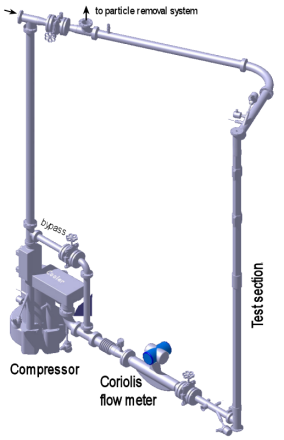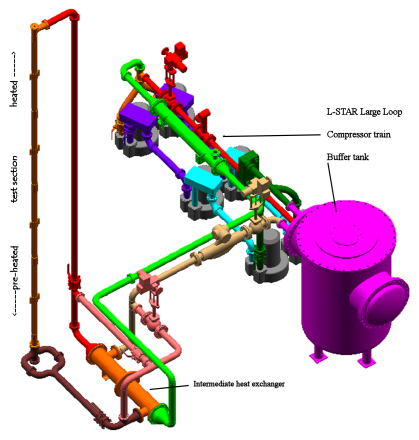L-STAR
| L-STAR: | Luft – STab, Abstandshalter, und Rauigkeiten (Air – rod, spacer grid, and roughness) |
When in a subsystem of a power station heat is transferred to a fluid via solid structures, the efficiency of the system can be increased by increasing the outlet fluid temperature. For the envisaged temperature regimes, gas-cooled systems are favourable. To limit the thermal loads on the structures, the heat transfer should be increased. This can for example be done by structuring the surface with ribs or dimples that enhance the near-wall mixing of the fluid.
To improve the respective knowledge, L-STAR has been set up as an experimental project to investigate in detail the issues of gas cooling of rod geometries, in particular the enhancement of the heat transfer by structured surfaces, the effects of intensive heating, and the effect of mixed convection in hexagonal channels.
A key element of the L-STAR experiments is the application of high definition flow field measurement techniques, such as Laser-Doppler anemometry. Their spatial resolution must be high enough to allow flow structure measurements between the structuring elements in the close vicinity of both the surface structures and the wall. The flow field measurements are complemented by measurements of wall temperatures and gas pressures to provide comprehensive data to study the structure of the flow field and the integral effects. The project is complemented by extensive numerical investigations.
The main objectives of the project are
- to study the influence of the walls on the flow structures and the effects of different wall topologies
- to establish a database for the improvement and qualification of computational fluid dynamics (CFD) codes, to simulate turbulent flows in the vicinity of textured surfaces
- to provide friction and heat transfer correlations suitable for system codes
- to contribute to the technology development of gas loops (particle removal, transient behaviour and control, spacer geometries, fatigue and wear)
Experimental parameters in this project are relevant for gas cooled nuclear systems as investigated internationally in the Generation IV framework for high temperature reactors with high efficiency.
The project comprises two loops: a small one, L-STAR/SL, that is already in operation and a large one, L-STAR/LL, that is projected. The test section of both loops is a hexagonal tube with a cylindrical heated rod inside. Though helium would be preferable as a fluid, air is used instead to avoid the high costs of a helium loop. Both loops cover the whole range from the transitional regime up to the highly turbulent flow. Individual parameters of the two loops are given below.
| L-STAR/SL | L-STAR/LL | |
| Length of test section (m) | 3.7 | variable |
| Maximum electrical power (kW) | 24 | variable |
| Inlet temperature (°C) | ambient temperature | ambient temperature |
| Maximum rod temperature (°C) | 700 | variable |
| Maximum operation pressure (MPa) | 0.3 | 0.3 |
| Maximum mass flow rate (kg/s) | 0.33 | 0.66 |
 |
 |
|
| L-STAR Small Loop | L-STAR Large Loop |
Instrumentation covers a variety of resistive thermal sensors (PT100) and thermocouple sensors, a Coriolis flow meter to measure the mass flow rate, a Pitot sensor, high precision differential pressure sensors as well as a number of conventional pressure sensors distributed before and after each main component. Two windows in the test section allow detailed measurements of the flow structure with advanced techniques like high resolution Laser Doppler Profile Sensor (LDPS), Particle Image Velocimetry (PIV), and Laser Induced Fluorescence (LIF) for measurements.
In the frame of our CFD (Computational Fluid Dynamics) activities, ANSYS CFX and TRACE are used for the analysis of the thermal-hydraulic issues, studied in the L-STAR facility.
The compressor train of the large loop is currently used as a test bed for fusion technology to test a pre-test mock-up experiment (PREMUX), where a slice of the breeder unit of a fusion reactor is investigated.
Within the GoFastR project of the 7th EU framework programme, a blind code benchmark for CFD codes was performed, where the pressure and temperature distribution with a hexagonal tube, heated by a single rod, was to be calculated. Presently, the L-STAR project is integrated in the EU collaborative project THINS (Thermal-Hydraulics of Innovative Nuclear Systems).
References
| [1] | Rehme, K.: Pressure Drop Correlations for Fuel Element Spacers. Nuclear Technology Vol. 17, 1973. |
| [2] | Hassan, M.A., Rehme, K.: Heat Transfer near Spacer Grids in Gas-cooled Rod Bundles. Nuclear Technology Vol. 52, 1981. |
| [3] | Schikorr, M.: Nuclear Requirements for HELOKA-HP. Seminar FZK-CEA-AREVA He-Technology, Karlsruhe, 5 April, 2005. |
| [4] | Hering W., Arbeiter, F., Bologa, A., Jianu, A., Zhuang, J.: Investigation of Heat Transfer for Gas Cooled Systems. Internat. Congress on Advances in Nuclear Power Plants (ICAPP '08), Anaheim, CA, USA, June 8–12, 2008, Transactions of the American Nuclear Society, 98, 2008. |
| [5] | Gomez R., Böttcher M., Krüssmann R., Aberle J., Jianu A., Scherrer S., Zhuang J., Arbeiter F., Hering W.: Experimental and Numerical Investigation on Pressure Drop for Turbulent Annular Air Flow in Hexagonal Channels. 15th International Topical Meeting on Nuclear Reactor Thermalhydraulics – NURETH 15, May 12–16, 2013, Pisa (Italy). |
| [6] | Ján Kubacka J., Ján Remiš J., Gomez de Leija R., Scherrer S., Kruessmann R: CFD Model of L-STAR/SL Loop – GoFastR project. 4th International Youth Conference on Energy (IYCE), June 6th–8th, 2013, Siófok, Hungary. |
